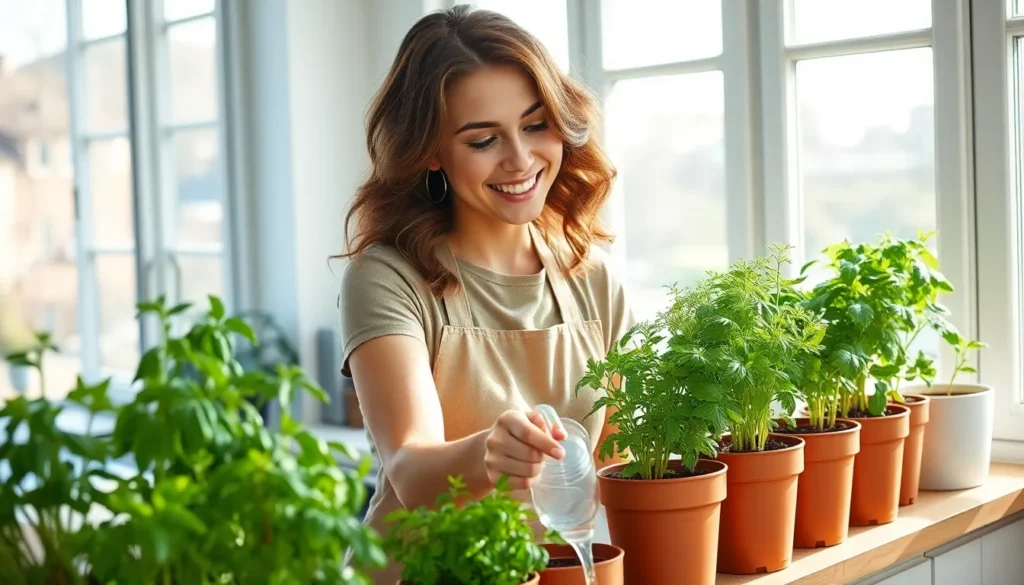We’ve all been there – reaching for fresh herbs while cooking only to find wilted store-bought sprigs that cost more than they’re worth. Growing herbs indoors transforms your kitchen into a year-round garden that’s both practical and rewarding. You’ll never run out of fresh basil for pasta night or mint for your morning tea again.
Indoor herb gardening isn’t just about convenience – it’s about taking control of your culinary experience. We’re talking about herbs that are fresher than anything you’ll find at the grocery store, grown without pesticides, and available 24/7 right from your windowsill. Plus, there’s something deeply satisfying about snipping herbs you’ve nurtured from tiny seeds.
Whether you’re a complete beginner or someone who’s killed every plant they’ve touched, we’ll show you exactly how to create a thriving indoor herb garden that fits your space and lifestyle.
Choose the Right Herbs for Indoor Growing
Starting your indoor herb garden requires selecting varieties that’ll flourish in your home environment. We’ll explore the most successful herbs for indoor cultivation based on their adaptability and growth characteristics.
Best Beginner-Friendly Herbs
Basil tops our list as the most forgiving herb for new indoor gardeners. This aromatic plant grows quickly in bright windowsills and tolerates occasional watering mistakes. Sweet basil varieties like Genovese produce abundant leaves within 6-8 weeks of planting.
Mint varieties excel indoors because they adapt to various light conditions and grow aggressively in containers. Spearmint and peppermint species thrive in pots, preventing them from overtaking your garden space. These herbs produce fresh leaves continuously when you harvest them regularly.
Chives offer year-round harvests with minimal care requirements. These onion-flavored herbs tolerate lower light levels than most cooking herbs and regrow quickly after cutting. We recommend starting with common chives or garlic chives for consistent results.
Oregano provides robust flavor while requiring little maintenance from beginning gardeners. This Mediterranean herb prefers slightly dry soil between waterings and produces small leaves perfect for cooking. Greek oregano and Italian oregano varieties perform exceptionally well in indoor containers.
Herbs That Thrive in Low Light Conditions
Parsley flourishes in partial shade making it ideal for kitchens with limited direct sunlight. Flat-leaf and curly varieties both adapt to 4-6 hours of indirect light daily. These biennial herbs provide fresh garnishes and cooking ingredients throughout most of the year.
Cilantro prefers cooler, shadier spots compared to sun-loving Mediterranean herbs. This fast-growing annual produces tender leaves in north-facing windows or under grow lights. We suggest succession planting every 2-3 weeks for continuous harvests.
Lemon balm tolerates low light environments while maintaining its citrusy fragrance and flavor. This perennial herb grows well in areas receiving morning sun or bright artificial lighting. The leaves make excellent teas and add fresh notes to summer drinks.
Thyme species adapt to various lighting conditions including partial shade situations. Creeping thyme and common thyme both produce flavorful leaves in moderate light levels. These compact plants work well in small spaces with limited sun exposure.
Space-Saving Herb Varieties
Dwarf basil cultivars maximize small growing areas while providing full-sized flavor profiles. Spicy Globe basil and Greek basil varieties stay under 12 inches tall in containers. These compact plants produce dense foliage perfect for apartment windowsill gardens.
Compact rosemary varieties fit tight spaces without sacrificing aromatic qualities. Prostrate rosemary and Arp rosemary cultivars maintain manageable sizes in 6-8 inch pots. We recommend these varieties for their upright growth habits and space efficiency.
Micro green herbs offer quick harvests in minimal square footage. Baby lettuce, micro cilantro, and young arugula provide fresh flavors within 2-3 weeks of seeding. These fast-growing options work perfectly in shallow trays or small containers.
Trailing herbs use vertical space effectively in hanging planters or wall-mounted systems. Trailing oregano and cascading thyme varieties spill beautifully from elevated containers. These hanging herb gardens create living walls while maximizing your available growing area.
Select the Perfect Indoor Growing Location
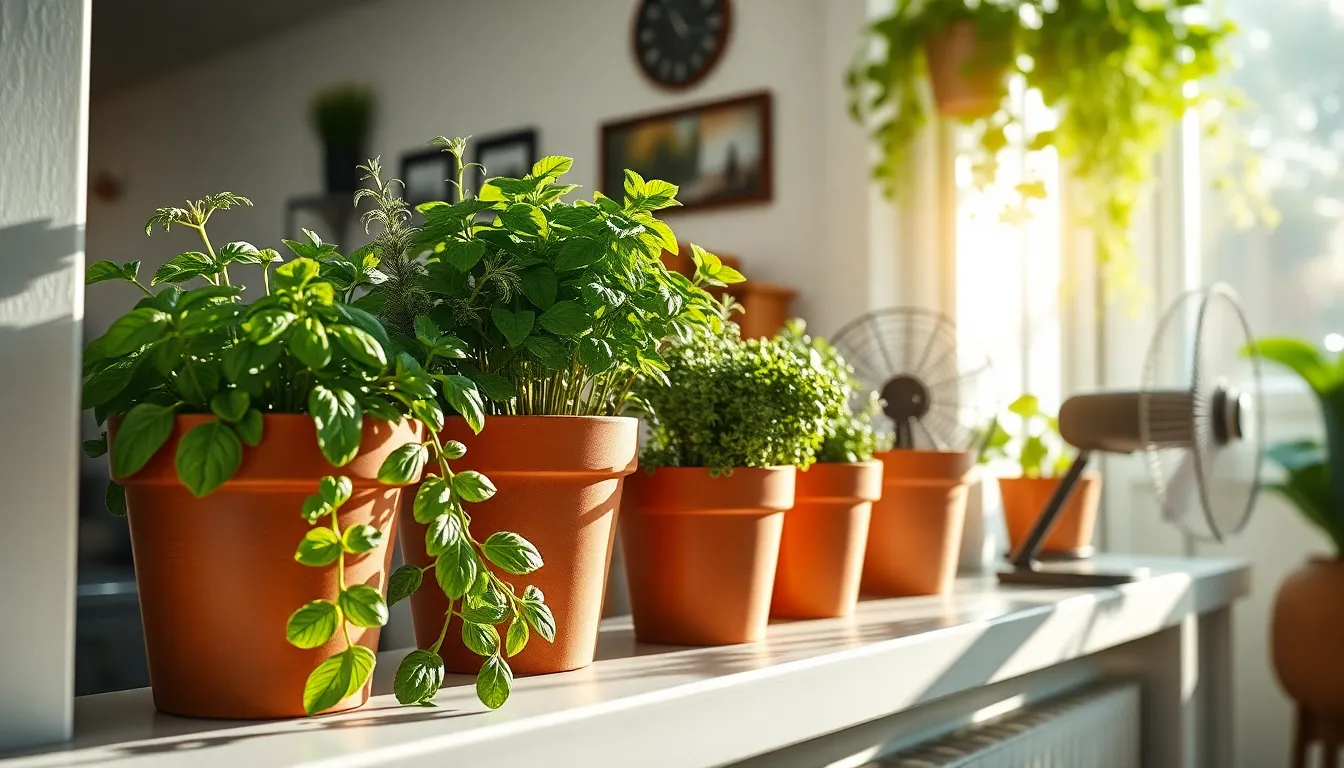
We’ll need to carefully consider several environmental factors to ensure our indoor herbs thrive in their new home. Choosing the right spot makes the difference between struggling plants and a flourishing herb garden.
Evaluating Natural Light Sources
South-facing windows provide the most intense light throughout the day, making them ideal for most herbs requiring at least six hours of direct sunlight daily. We recommend positioning sun-loving herbs like basil, rosemary, and thyme in these premium spots to maximize their growth potential.
Southwest and west-facing windows offer excellent alternatives for herbs that don’t demand peak light intensity. These locations work particularly well for mint, parsley, and oregano, which can adapt to less direct sunlight while still producing abundant harvests.
East-facing windows receive gentle morning light that’s perfect for delicate herbs like cilantro and chives. We find these spots prevent the leaf burn that can occur with too much intense afternoon sun.
Temperature and Humidity Requirements
Optimal temperature ranges fall between 65°F and 75°F (18°C to 24°C) during daytime hours for most indoor herbs. We’ve observed that maintaining slightly cooler nighttime temperatures by 5-10 degrees promotes healthier root development and prevents stress.
Humidity levels should remain moderate to prevent fungal diseases that thrive in overly moist conditions. We suggest using a humidity meter to monitor levels and ensuring they stay between 40-60% for optimal herb growth.
Temperature consistency matters more than achieving perfect numbers, so we avoid placing herbs near heating vents, radiators, or frequently opened doors that create temperature fluctuations.
Air Circulation Considerations
Adequate spacing between plants prevents overcrowding and allows air to flow freely around each herb. We maintain at least 6 inches between pots to reduce the risk of fungal diseases and pest infestations.
Gentle air movement promotes stronger stems and healthier foliage, so we often use small fans on low settings to create subtle circulation. This movement also helps prevent stagnant air pockets where moisture can accumulate.
Strategic ventilation involves opening windows periodically when weather permits or using exhaust fans to refresh the air around our herb garden. We avoid creating strong drafts that can stress plants while ensuring enough movement to keep the growing environment healthy.
Gather Essential Growing Equipment and Supplies
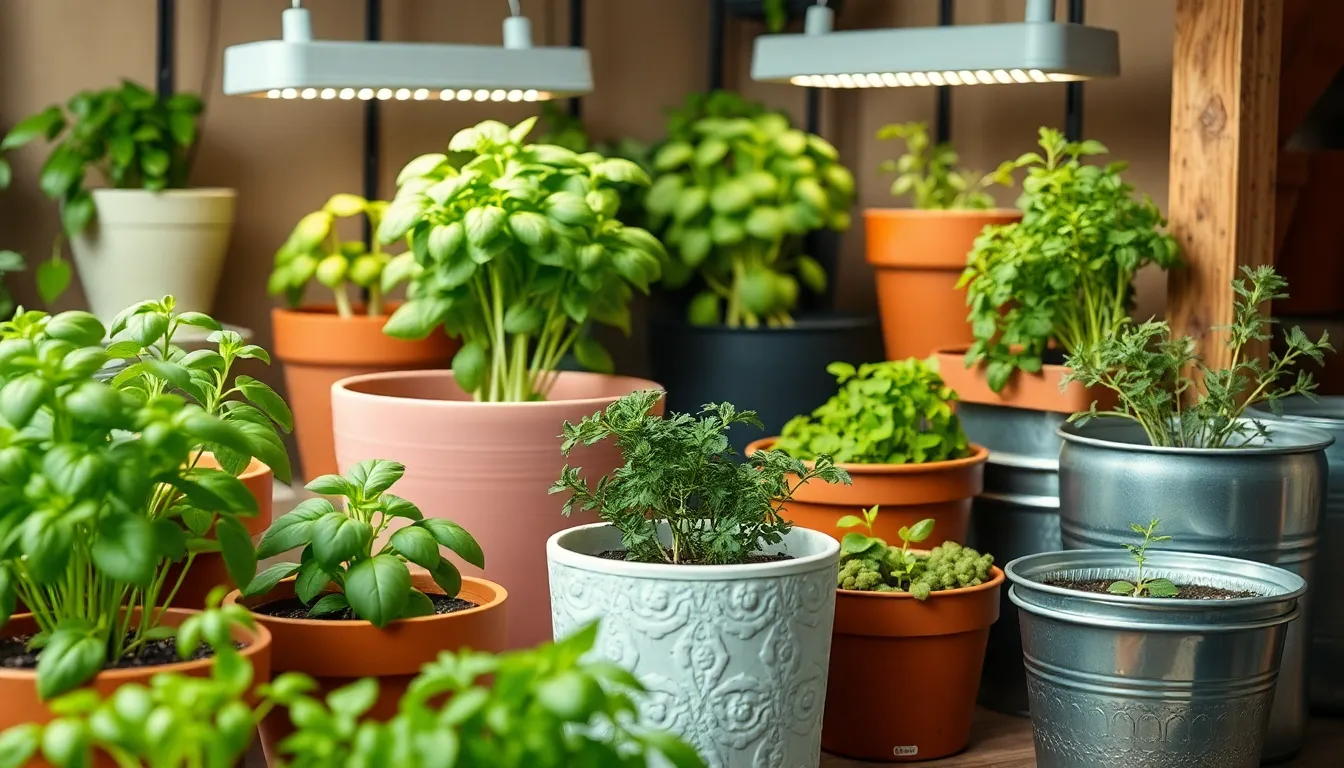
We’ll transform your indoor space into a thriving herb garden with the right equipment and supplies. Having quality materials from the start ensures our herbs grow strong and healthy throughout their lifecycle.
Container Options and Drainage Requirements
Terracotta pots offer exceptional breathability and work perfectly for herbs like oregano that prefer slightly drier conditions. These clay containers naturally wick away excess moisture while allowing air to reach the roots.
Ceramic containers suit herbs preferring consistently moist soil like basil since they retain water longer than porous materials. We recommend choosing glazed ceramic options for their durability and attractive appearance.
Plastic pots provide lightweight convenience and cost effectiveness but may retain too much moisture for some herbs. Adding extra drainage holes prevents water from pooling at the bottom.
Metal containers deliver affordable options though they often require additional drainage modifications. We suggest drilling several holes in the bottom before planting to ensure proper water flow.
Every container must have adequate drainage holes to prevent root rot regardless of material choice. Placing a layer of small stones or pottery shards at the bottom improves drainage further.
Soil and Growing Medium Selection
High quality potting mix designed specifically for indoor plants provides the foundation for healthy herb growth. We need soil that retains moisture while draining excess water to prevent fungal diseases.
Well draining formulas prevent waterlogged conditions that kill herb roots within days. Look for mixes containing perlite or vermiculite to improve aeration and drainage properties.
Nutrient rich blends eliminate the need for frequent fertilizing during the early growing stages. We recommend avoiding garden soil since it compacts easily in containers and may contain harmful bacteria.
pH balanced mixtures between 6.0 and 7.0 support optimal nutrient absorption for most culinary herbs. Testing soil pH before planting ensures our herbs can access essential minerals effectively.
LED Grow Lights and Timing Systems
LED grow lights provide the necessary spectrum and intensity for robust indoor herb growth while consuming minimal energy. These efficient fixtures can mimic natural daylight patterns throughout the year.
Full spectrum LEDs deliver both blue and red light wavelengths that herbs need for photosynthesis and flowering. We position lights 12 to 18 inches above plants for optimal coverage without burning delicate leaves.
Timing systems ensure consistent lighting schedules of 12 to 14 hours per day that herbs require for healthy development. Automatic timers eliminate guesswork and maintain regular light cycles even when we’re away.
Adjustable fixtures allow us to raise lights as herbs grow taller and modify intensity based on seasonal needs. We can customize lighting duration for different herb varieties since some require longer exposure periods than others.
Master the Art of Planting and Transplanting
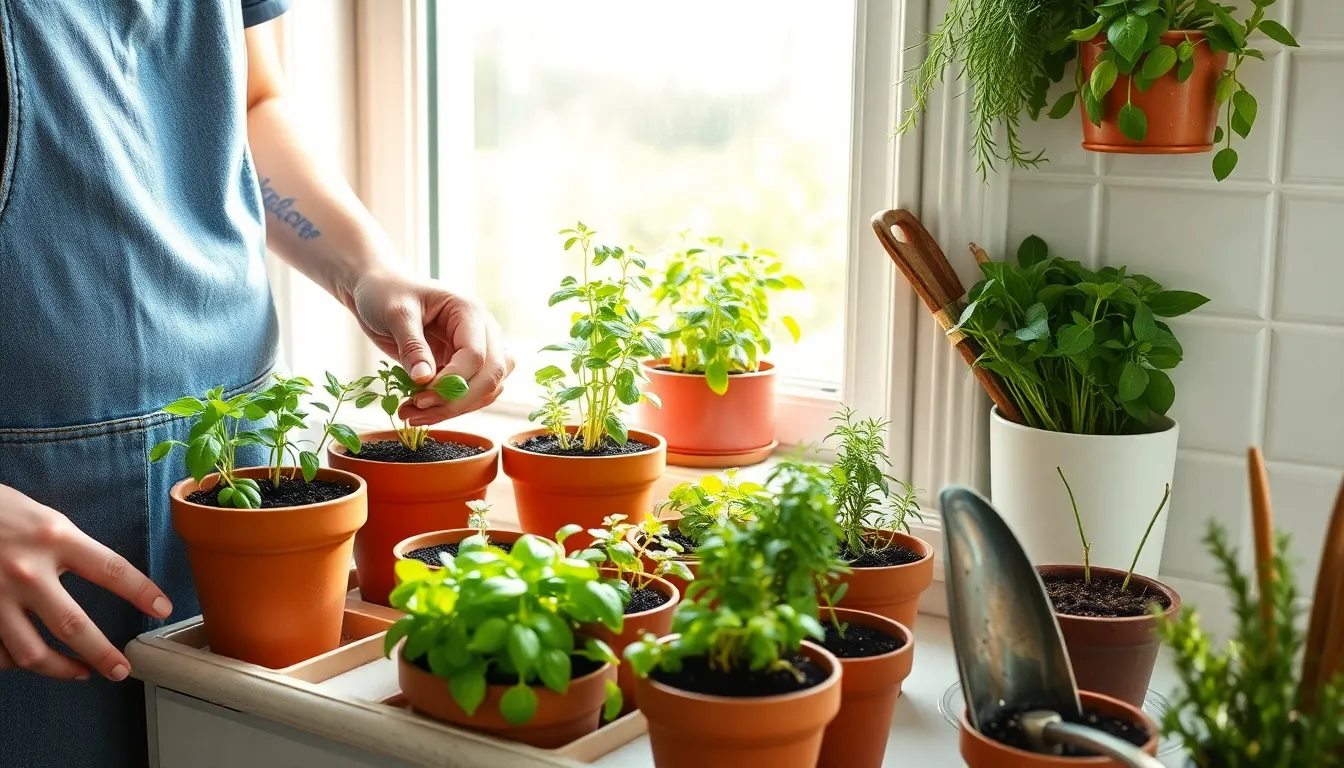
Now that we’ve covered location and equipment, let’s jump into the crucial techniques that’ll make your indoor herb garden thrive.
Starting from Seeds vs. Seedlings
Seeds offer greater variety and complete control over your herb garden from the very beginning. We can choose from hundreds of herb varieties when starting from seeds, but this method requires patience and careful attention to moisture and warmth levels. Seeds need consistent temperatures between 65-75°F and steady moisture to germinate successfully.
Seedlings provide a head start for beginners who want faster results. We recommend transplanting young plants for those new to indoor gardening since they’re already established and less likely to fail. Seedlings should always be handled gently during the transplanting process to avoid disturbing their delicate root systems.
Proper Planting Depth and Spacing
Plant seeds at twice their diameter to ensure proper germination and root development. We follow this simple rule: tiny basil seeds go about 1/8 inch deep, while larger oregano seeds need 1/4 inch coverage. Most herbs only require 6 inches of soil depth since they’re shallow rooted plants.
Space plants according to their mature size to prevent overcrowding and disease issues. We give each herb enough room for proper air circulation, which reduces the risk of fungal problems. Container size should accommodate the root ball comfortably without being excessively large, as oversized pots can lead to waterlogged soil conditions.
Transplanting Techniques for Healthy Growth
Choose containers with drainage holes as your first priority to prevent deadly root rot. We prefer terra cotta pots because they regulate moisture naturally and provide excellent aeration for herb roots. These clay containers allow excess water to evaporate through their porous walls.
Loosen root balls gently before placing herbs into their new containers. We transplant at the same soil depth the plant was growing previously to avoid shocking the root system. Never bury the stem deeper than it was in the original container.
Water from the bottom or top immediately after transplanting, ensuring soil stays moist but never soggy. We’ve found that overwatering causes more indoor herb failures than any other factor. The soil should feel like a wrung out sponge rather than dripping wet.
Provide 6+ hours of direct sunlight from south facing windows or supplement with full spectrum grow lights. We position LED grow lights within 12 inches of plants and run them for 12-16 hours daily to replicate natural growing conditions.
Use fast draining potting soil blends customized to your exact herbs’ needs. We mix cactus soil with regular potting mix for Mediterranean herbs like rosemary and thyme, while basil and mint thrive in standard potting soil. Regular liquid houseplant fertilizer applied monthly supports steady growth throughout the growing season.
Establish a Consistent Watering and Feeding Schedule
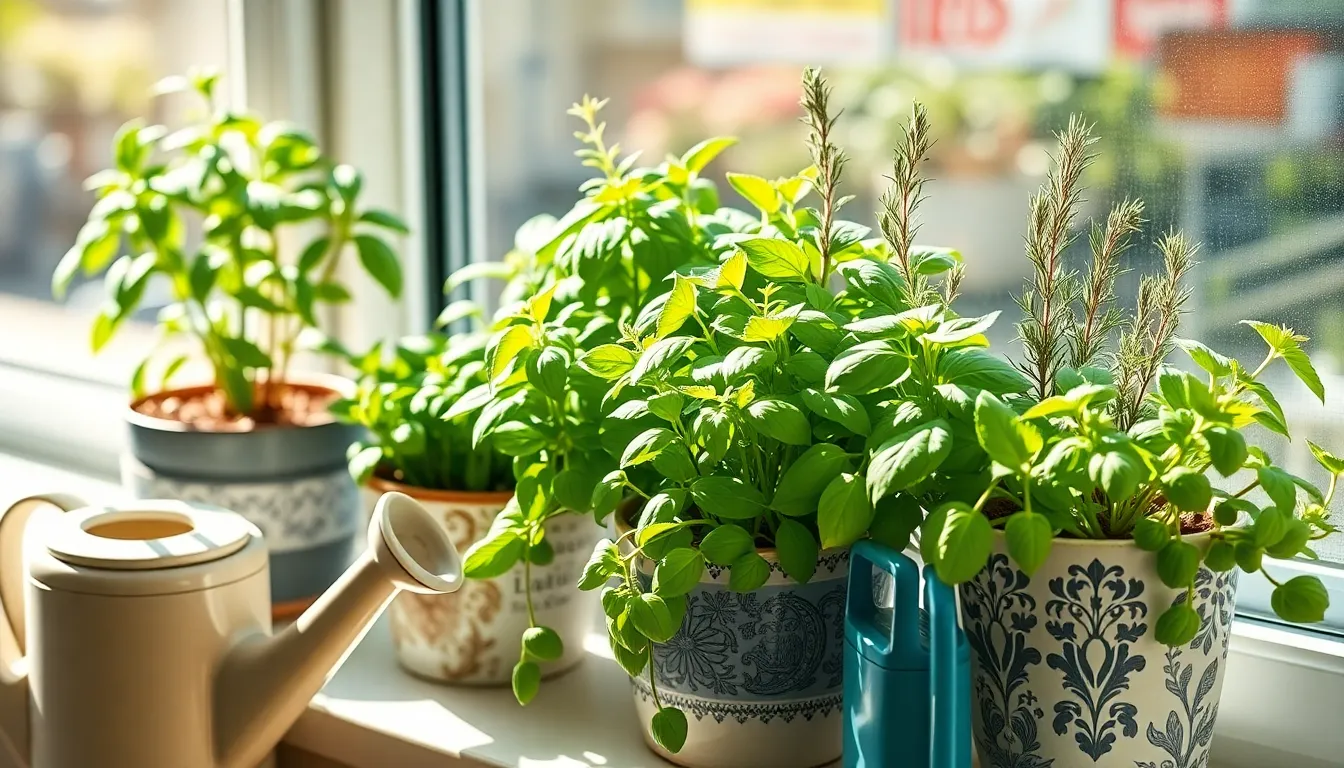
Creating a proper watering and feeding routine ensures our indoor herbs thrive throughout their growing cycle. Consistent care prevents common issues like root rot while promoting healthy, flavorful growth.
Understanding Watering Frequency and Amount
Water when the top inch of soil feels dry to the touch. This simple test prevents both overwatering and underwatering issues. We recommend checking soil moisture every 2-3 days by inserting your finger directly into the potting mix.
Bottom watering provides the most effective moisture distribution. This method prevents soil displacement and ensures even water absorption throughout the root system. Place containers in a shallow tray filled with water and allow the soil to absorb moisture from drainage holes.
Different herbs require varying moisture levels based on their origins. Mediterranean varieties like rosemary and thyme prefer drier conditions between waterings. Moisture loving herbs such as basil and mint need more frequent watering to maintain optimal growth.
Avoid waterlogged conditions that lead to root problems. Excess water should drain freely from containers within 30 minutes of watering. Standing water creates anaerobic conditions that damage root systems and invite bacterial infections.
Fertilizer Types and Application Methods
Use balanced, water soluble houseplant fertilizer for most indoor herbs. These formulations provide essential nutrients without overwhelming delicate root systems. Dilute fertilizer to half strength to prevent nutrient burn and excessive leaf growth.
Apply fertilizer once or twice monthly during active growing periods. Herbs grown primarily for leaves benefit from nitrogen rich formulations. Those grown for flowers or seeds need balanced NPK ratios to support complete development.
Mediterranean herbs require specialized soil and feeding approaches. Mix cactus potting blend with regular potting soil for varieties like rosemary and thyme. These herbs prefer lean soil conditions and minimal fertilization to maintain their concentrated flavors.
Regular potting soil works best for leafy herbs like basil and mint. These fast growing varieties benefit from nutrient rich environments. Standard houseplant potting mixes provide adequate nutrition for sustained harvesting.
Recognizing Signs of Over and Under-Watering
Overwatered herbs display soft, mushy stems and yellowing lower leaves. Root rot appears as black, slimy roots that smell unpleasant when disturbed. These symptoms indicate immediate drainage improvements and reduced watering frequency are necessary.
Underwatered plants show wilted leaves and completely dry soil surfaces. Basil leaves curl inward and mint stems droop noticeably when moisture stressed. Recovery occurs quickly once proper watering resumes.
Check soil moisture levels before watering to prevent problems. Stick your finger 1-2 inches into the soil around plant bases. Dry conditions warrant immediate watering while moist soil indicates delayed watering needs.
Monitor plant behavior to adjust watering schedules seasonally. Herbs require less water during winter months when growth slows naturally. Summer heat and longer daylight hours increase water consumption and evaporation rates significantly.
Maintain Optimal Growing Conditions Year-Round

Creating the perfect environment for your indoor herbs requires ongoing attention to several key factors that change throughout the seasons.
Monitoring Light Exposure and Duration
Light duration becomes critical when we’re growing herbs indoors since most varieties need at least 6 hours of direct sunlight daily. Positioning your herb containers near south or west-facing windows provides the ideal natural light exposure for optimal photosynthesis.
Seasonal light changes require us to adapt our growing strategy, especially during winter months when natural daylight decreases significantly. Supplemental grow lights offer an effective solution for maintaining consistent light levels throughout darker periods of the year.
Measuring daily exposure helps ensure our herbs receive adequate energy for healthy growth and robust flavor development. We can track light duration using simple timers or smartphone apps that monitor daylight hours in our exact location.
Managing Indoor Temperature Fluctuations
Temperature consistency plays a vital role in herb development, with optimal daytime ranges between 65°F and 75°F (18°C and 24°C) promoting healthy growth patterns. Nighttime temperatures should drop to 50°F to 60°F (10°C to 15°C) to encourage compact, sturdy plant structure.
Avoiding temperature swings prevents stress that can weaken our herbs and make them susceptible to various problems. We achieve this stability by positioning plants away from heating vents, air conditioning units, and frequently opened doors or windows.
Monitoring tools like digital thermometers with min/max readings help us track temperature variations throughout the day and night. Consistent temperature control also reduces insect problems that often arise when plants experience thermal stress.
Preventing Common Pest and Disease Issues
Regular plant inspections should occur weekly to catch early signs of common pests like spider mites, aphids, or whiteflies before they establish colonies. We examine both upper and lower leaf surfaces, stems, and soil for any unusual spots, webbing, or moving insects.
Proper air circulation prevents the stagnant conditions that encourage fungal diseases and pest infestations in our indoor growing space. Maintaining adequate spacing between plants and using small fans creates gentle airflow that strengthens stems and reduces humidity around foliage.
Preventive hygiene practices include regularly cleaning pots, tools, and growing surfaces to eliminate disease pathogens before they spread. We avoid overwatering by using well-draining soil and checking moisture levels before adding water, since soggy conditions promote root rot and other fungal issues.
Disease management requires us to remove any affected plant material immediately and adjust watering practices to prevent future outbreaks. Cool nighttime temperatures naturally help reduce insect activity while promoting stronger, more resilient herb growth.
Harvest Your Herbs at Peak Freshness

Now that we’ve established optimal growing conditions, we’re ready to enjoy the fruits of our indoor herb garden. Harvesting at the right time ensures we capture maximum flavor and aroma from our homegrown herbs.
Timing Your First Harvest Correctly
We should begin harvesting when our herb plants have developed multiple sets of true leaves and stand well-established, typically reaching about 6 inches in height. This usually occurs a few weeks after transplanting when the plants have had sufficient time to develop strong root systems.
Never harvest more than one-third of the plant at a time to prevent stress and maintain continued growth. We want to give our herbs enough foliage to photosynthesize and sustain themselves while we enjoy regular harvests. Young plants need time to establish themselves before we start taking cuttings regularly.
Proper Cutting Techniques for Continued Growth
We’ll use clean, sharp scissors or pruners to make precise cuts that promote healthy regrowth. Cut stems just above a pair of healthy leaves or nodes to encourage bushier growth and new shoots from below the cutting point. This technique stimulates the plant to produce multiple stems instead of growing tall and spindly.
Regular light harvesting creates thicker, more productive plants that yield better harvests over time. For leafy herbs like basil and mint, we should pinch off the tops to prevent flowering and maintain leaf production. When herbs start to flower, they often become bitter and lose their culinary appeal.
Storing and Preserving Fresh Indoor Herbs
We can store freshly cut herbs in a container or glass of water, similar to arranging a bouquet, keeping them at room temperature or in the refrigerator for up to a week. This method works particularly well for herbs with tender stems like basil and cilantro.
For longer preservation, we have several effective options:
Drying Method: Bundle small bunches and hang them upside down in a warm, dry, well-ventilated area away from direct sunlight. Alternatively, lay individual leaves on a baking sheet and dry them in a low oven for quicker results.
Freezing Method: Chop herbs and pack them into ice cube trays filled with water or olive oil for convenient portioning. This technique preserves herbs for months while maintaining much of their fresh flavor for cooking.
We should harvest herbs in the morning after dew has dried but before temperatures rise, when essential oils responsible for flavor and scent reach their highest concentration.
Troubleshoot Common Indoor Herb Growing Problems

Even experienced gardeners encounter challenges when growing herbs indoors, but most issues have straightforward answers.
Addressing Yellowing or Dropping Leaves
Overwatering stands as the primary culprit behind yellowing leaves in indoor herbs. We often see this problem when gardeners water too frequently without checking soil moisture levels first. Test the soil with your finger – it should feel dry about an inch below the surface before watering again.
Light deficiency causes leaves to turn yellow and eventually drop as plants struggle to photosynthesize effectively. Position your herbs near south-facing windows where they’ll receive at least 6 hours of direct sunlight daily. Supplement with grow lights during winter months when natural daylight decreases significantly.
Temperature fluctuations stress indoor herbs and trigger leaf yellowing, especially when plants experience sudden changes near drafty windows or heating vents. Maintain consistent temperatures between 65-75°F during the day and avoid placing containers where they’ll face dramatic temperature swings.
Nutrient deficiencies manifest as yellowing leaves when herbs haven’t received proper fertilization for extended periods. Apply balanced fertilizers monthly during growing seasons, but use weak answers since herbs don’t require heavy feeding like other houseplants.
Solving Poor Growth and Weak Stems
Insufficient lighting creates the most common cause of weak, leggy stems in indoor herb gardens. Herbs that don’t receive adequate light stretch toward available light sources, resulting in tall but fragile growth patterns. Move containers to brighter locations or install full-spectrum LED grow lights positioned 6-12 inches above plant tops.
Poor soil quality restricts root development and leads to stunted growth in indoor herbs. Replace regular potting soil with well-draining herb-exact mixes that contain perlite or vermiculite for improved drainage. Terra cotta pots help regulate moisture levels naturally and prevent soil from becoming waterlogged.
Inadequate nutrition weakens stem structure when herbs don’t receive essential nutrients for healthy development. Feed your indoor herbs with diluted liquid fertilizer every 2-3 weeks during active growing periods. Choose fertilizers with balanced N-P-K ratios specifically formulated for herbs and vegetables.
Overcrowding restricts air circulation and forces herbs to compete for limited resources, resulting in weak growth patterns. Space containers appropriately and thin overcrowded seedlings to give remaining plants room to develop strong root systems and sturdy stems.
Preventing Root Rot and Fungal Issues
Excessive moisture creates ideal conditions for root rot development in indoor herb containers. Ensure all pots have drainage holes and empty saucers within 30 minutes after watering to prevent standing water accumulation. Check soil moisture regularly rather than following rigid watering schedules.
Poor air circulation promotes fungal growth around indoor herbs, especially in humid environments or crowded growing areas. Position a small fan nearby to maintain gentle air movement, or space containers to allow natural airflow between plants. This reduces humidity levels around foliage and prevents moisture buildup.
Contaminated tools spread fungal diseases between healthy plants during routine maintenance activities. Clean pruning shears with rubbing alcohol between plants and wash hands thoroughly after handling any herbs showing signs of disease. Remove affected plant material immediately and dispose of it away from your growing area.
High humidity levels encourage fungal problems in indoor growing environments, particularly during winter months when homes are sealed tightly. Monitor humidity with a simple hygrometer and maintain levels between 40-60% for optimal herb health. Use dehumidifiers if necessary to control excess moisture in your growing space.
Conclusion
Growing herbs indoors transforms your kitchen into a culinary haven where fresh flavors are always within reach. We’ve shown you that with the right knowledge and techniques anyone can successfully cultivate a thriving indoor herb garden regardless of experience level.
The journey from seedling to harvest requires attention to detail but the rewards are immeasurable. Fresh basil for your pasta oregano for your pizza and mint for your tea – all grown by your own hands in the comfort of your home.
Remember that consistency is key in indoor herb gardening. Regular monitoring proper watering and maintaining optimal growing conditions will ensure your herbs flourish year-round. With these skills you’ll never have to settle for wilted store-bought herbs again.
Your indoor herb garden awaits – it’s time to start growing!
Frequently Asked Questions
What are the best herbs for beginners to grow indoors?
The best beginner-friendly herbs include basil, mint, chives, and oregano. These herbs are relatively easy to care for and adapt well to indoor conditions. For low-light environments, consider parsley, cilantro, and lemon balm, which can thrive with less natural sunlight.
How much light do indoor herbs need?
Most herbs require 4-6 hours of direct sunlight daily or 12-16 hours under grow lights. During winter months when natural daylight decreases, supplemental grow lights become essential to maintain healthy growth and prevent leggy, weak plants.
What type of containers should I use for indoor herbs?
Choose containers with drainage holes to prevent waterlogging. Pots should be at least 6-8 inches deep for most herbs. Terra cotta, ceramic, or plastic containers all work well, but ensure they’re appropriately sized for your chosen herbs’ root systems.
How often should I water my indoor herbs?
Check soil moisture by inserting your finger 1-2 inches deep. Water when the top inch feels dry, typically every 2-4 days depending on humidity and temperature. Adjust watering frequency seasonally, as herbs need less water during cooler months.
When can I start harvesting my herbs?
Begin harvesting when plants have multiple sets of true leaves and reach about 6 inches tall. Never harvest more than one-third of the plant at once to prevent stress. Regular light harvesting encourages bushier growth and maintains productivity.
Why are my herb leaves turning yellow?
Yellow leaves typically indicate overwatering, insufficient light, temperature fluctuations, or nutrient deficiencies. Check soil drainage, ensure adequate lighting, maintain consistent temperatures between 65-75°F, and consider using appropriate fertilizer for indoor herbs.
How do I prevent pests and diseases in my indoor herb garden?
Maintain proper air circulation, avoid overwatering, and inspect plants regularly for signs of pests or disease. Keep gardening tools clean, ensure adequate spacing between plants, and monitor humidity levels to prevent fungal issues like root rot.
What’s the best way to store fresh harvested herbs?
Harvest herbs in the morning after dew has dried for maximum flavor concentration. Store fresh herbs in the refrigerator wrapped in damp paper towels, or preserve them by drying or freezing to extend shelf life while retaining flavor.

